
Once again, I sit here in front of my trusty MacBook Pro on the anniversary of the day I was born, pondering what if anything it means that I’ve turned 69.
Won’t mean much if the Mayan calendar cultists turn out to be right on December 21. In which case I’ll have squandered my last few precious days. Having survived quite a few such predictions by this time, I haven’t even laid in a supply of bottled water. Based on my experience to date, I’ll hunker down and take precautions for hurricanes and such. If the world comes to an end — Mayan doomsday, zombie apocalypse, asteroid collision — I’ll go with it.
As a sign of my optimism, a few days before my birthday I decided to go in for the first eye exam I’ve had since 1994. (Not the fictional one I concocted for one of my summer posts on the trope of the well-made photograph.) I’d worn glasses since about age 11, but stopped using them some years ago except when driving — I’d begun to find them irritating and unnecessary in most situations.
Turns out I’ve gone from 20/200 (right) and 20/400 (left) to 20/80 (right) and 20/95 (left), actually getting better with age. I also manifest no signs of glaucoma, macular degeneration, or other impediments to clear seeing. Reassuring to me and, I hope, to my readers and the subjects of my critiques alike. So I ordered new glasses (partly covered by Medicare), which I’ll pick up next week and will rarely use. The exam did introduce me to the state-of-the-art digital tools of 21st-century opthalmology, amazing stuff that enabled my doctor and me to study images of the rear walls of my eyeballs. Ain’t science wonderful? Ain’t nature grand?
Tech Stasis

MacBook Pro, 15-inch model, 2007
Unlike last year, I made no major upgrades in either hardware or software this year for this MacBook Pro, my primary professional tool. Indeed, for the tech-inclined Mac addicts among you, I’m still running Snow Leopard, having opted not to move (yet) to Lion/Mountain Lion, released in July 2011. This puts me the furthest behind an Apple OS that I’ve ever been.
No good reason for lagging like this . . . except that I haven’t seen the need to update. All the software I use runs fine. Nothing in the latest iterations solves any problems I encounter. I take no pleasure in learning new (or revised) organizational systems, locations, layouts, commands, and other alterations of my work habits. I’ve opted to engage with a minimum number of apps: Word, Excel, Filemaker Pro, Keynote, Photoshop, Dreamweaver. This year I switched browsers from Safari to Firefox and then back, and substituted Google+ Hangouts for Skype for my online seminars. That’s enough change for me.
Consider this:
- I don’t own a tablet, and don’t regret that.
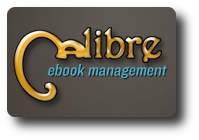 I don’t own an ebook reader, and don’t feel deprived. (I do have a freeware ebook app, Calibre, installed on my MacBook Pro.)
I don’t own an ebook reader, and don’t feel deprived. (I do have a freeware ebook app, Calibre, installed on my MacBook Pro.)- I don’t own an active cellphone, and feel no urgent need to fill that void. (I do own a jailbroken original-model iPhone, which came as a gift. I’ve never used it. I’m giving some thought to acquiring an iPod Touch and installing Skype for wifi-based VoIP.)
- I do have a chunk of my iTunes library on that iPhone, so I take it with me on long plane trips. I also have two iPods — one a bonus that came with my MBP, the other a thrift-shop find — that I take on such travels as well, loaded with audio files. I don’t carry any of them when I’m out and about, or use them when I’m working at home, because I prefer to listen to the sounds of the world around me.
- I actually dread having to learn and program any new “smart” digital device.
Which suggests that my wetware may have undergone some retrogressive modifications, or stabilized itself in what (by current standards of the speed of technological evolution) would be considered low gear. This leaves me less than ideally positioned for life amidst the suddenly emergent “Internet of Things” (IoT), in which I’m apparently considered a “digital immigrant” rather than a “digital native.”
Natives vs. Immigrants
These terms were coined more than a decade ago by Marc Prensky, who, according to CNN, “defines digital natives as those born into an innate ‘new culture’ while the digital immigrants are old-world settlers, who have lived in the analogue age and immigrated to the digital world. Although not Luddites, the immigrants struggle more than natives to adapt to hi-tech progress.” You might then call me an idIoT.
I have a problem with Prensky’s premise (click here for a PDF of an article by him), the same problem a Native American would have if described as an “immigrant” to eurocentric U.S. culture. The Native Americans were here first, then found themselves invaded and engulfed by the European hordes. Similarly, we analog-born “old-world settlers” predate the digital evolution. We didn’t “immigrate” to the digital environment; it invaded and surrounded us while we stayed in place.
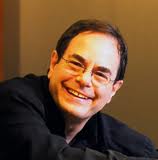
Marc Prensky
Specious analogies, no matter how TED-friendly, carry with them specious connotations as well as specious denotations. Prensky’s conceit suggests that people who remember experientially how things once were exist as aliens and newcomers in relation to how things are. This view excludes the possibility that the “digital natives,” lacking any substantial engagement with the preceding technologies, will have no dialectical understanding of their emergence, and thus no critical relationship to the paradigm shift they represent. As Marshall McLuhan wrote, “Whoever discovered water, it wasn’t a fish.”
Prensky’s position makes him the anti-Santayana: Those who remember the analog past — and especially those who lived through, were shaped by, and learned from it — are defined as disadvantaged in the brave new digital world. And, de facto, repeating the past (including its errors) won’t bother those who don’t know they’re doing so. It’s a pro-tabula rasa, anti-critical thinking posture, privileging those who take their technological environment for granted over those whose perspective on it might raise troubling questions.
So, one year older, I remain my technoskeptical self, perhaps a bit more cranky.
Keeping On Keeping On
I found no new regular print or online outlets for my writings in 2012, not for lack of trying. The tenuous situation of the independent freelance critic, as described in my fall 2011 Dinosaur Bones London lecture, increasingly resembles that of an endangered species with its habitat decimated.
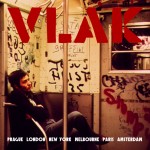 But I published a single essay in the annual compendium VLAK, self-described as “an international curatorial project with a broad focus on contemporary poetics, art, film, philosophy, music, science, design, politics, performance, ecology, and new media.” Plus multiple essays in several dependable platforms: Hotshoe, Photo Technique: Variations on the Photographic Arts, The Photograph Collector, European Photography. And of course numerous pieces in this blog and at my other websites. I also published introductions to print catalogues and monographs by Liu Xia and Maggie Taylor, and a “critic-in-residence” essay, “Archive as Artefact: The Black Star Picture Agency,” as a downloadable PDF file at the website of the Ryerson Image Centre in Toronto.
But I published a single essay in the annual compendium VLAK, self-described as “an international curatorial project with a broad focus on contemporary poetics, art, film, philosophy, music, science, design, politics, performance, ecology, and new media.” Plus multiple essays in several dependable platforms: Hotshoe, Photo Technique: Variations on the Photographic Arts, The Photograph Collector, European Photography. And of course numerous pieces in this blog and at my other websites. I also published introductions to print catalogues and monographs by Liu Xia and Maggie Taylor, and a “critic-in-residence” essay, “Archive as Artefact: The Black Star Picture Agency,” as a downloadable PDF file at the website of the Ryerson Image Centre in Toronto.
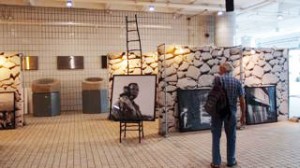
Liu Xia installation with the “Empty Chair,” Hong Kong, June 9, 2012. Photo © 2012 by A. D. Coleman.
In my role as an independent curator, I took on the re-curating and tour management of “The Silent Strength of Liu Xia,” the traveling exhibition of 26 photos by the dissident Chinese photographer, artist, and poet, wife of 2010 Nobel Peace Prize awardee Liu Xiaobo. I shepherded this remarkable show through high-profile presentations in Hong Kong, Taipei, Berlin, Madrid, and (in 2013) Richmond, VA. My co-curator Guy Sorman and I have suspended its tour temporarily, putting it on on hold as the new regime in Beijing sorts itself out. I expect it to resume its peregrinations next year, so I welcome queries from prospective venues.
My involvement with that project began shortly after “China: Insights,” the touring cross-section of contemporary documentary photography from mainland China that I curated with Gu Zheng of Fudan University, Shanghai, concluded its four-year, seven-stop tour at the Lowe Art Museum at the Univ. of Miami.
A. D. Coleman, Hong Kong Arts Centre, June 25, 2012. Photo © by Anna Lung.
The Liu Xia project preoccupied me for the middle half of the year, elbowing other projects onto the back burner. I hope to return to them in 2013. In late May through late June I traveled to Shenzhen, Hong Kong, and Beijing, much of that trip involving this show and related issues. I had no other travel obligations in all of 2012, a blessing.
In my role as lecturer I gave two short talks in conjunction with the Liu Xia exhibition in Hong Kong. Between November 2 and December 7 I made a cluster of presentations in New York:
- a keynote talk at a symposium sponsored by the Metropolitan Museum of Art;
- a dialogue premised on the “Dinosaur Bones” issues, with my old friend Doug Sheer at Artists Talk On Art (ATOA);
- and a dialogue with photographer and teacher Harold Feinstein, moderated by Sean Corcoran of the Museum of the City of New York, at Aperture.
All three events videotaped for posterity.
Happy Birthday to Me
My thanks to those readers who’ve emailed or called to offer birthday salutations.
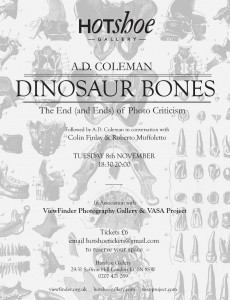 Lewis Lorton of Columbia, MD, hitherto unknown to me except as a subscriber to this blog, came across my Dinosaur Bones lecture earlier this month and took the trouble to email me a considered response. I thanked him, and suggested that he post it as a comment here. Instead, he opted to publish it at his own space, The Traveler’s Blog, under the title “A letter to A D Coleman, Critic.”
Lewis Lorton of Columbia, MD, hitherto unknown to me except as a subscriber to this blog, came across my Dinosaur Bones lecture earlier this month and took the trouble to email me a considered response. I thanked him, and suggested that he post it as a comment here. Instead, he opted to publish it at his own space, The Traveler’s Blog, under the title “A letter to A D Coleman, Critic.”
In it he engages at some length with the substance of that talk (refreshing in itself), also noting his dissatisfaction with photo-specific forums, about which I had much to say last January subsequent to the posting at one such site of a link to the “Dinosaur Bones” text. Mr. Lorton concludes his letter by saying, “I hope you live forever — or as least longer than I do — so I can continue to read your work.”
I can’t promise anything re my longevity, and won’t even swear that I’ll keep at this till they pry my MacBook Pro (or its eventual replacement) out of my cold dead fingers. But this enthusiasic reader’s encouragement did remind me why I persist, heartening me on an otherwise cheerless day. My thanks to him for my favorite birthday card this year.
The Thought that Counts
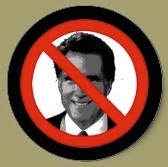 Best birthday present, hands down: The return to the White House of Barack Obama and, no less importantly, the defeat of Mitt Romney. As Romney himself said last January, “I believe in an America where millions of Americans believe in an America that’s the America millions of Americans believe in. That’s the America I love.” And the America that the majority of voting Americans believe in is an America in which Mitt Romney is not the president of the America they believe in. That’s the America that they and I all love.
Best birthday present, hands down: The return to the White House of Barack Obama and, no less importantly, the defeat of Mitt Romney. As Romney himself said last January, “I believe in an America where millions of Americans believe in an America that’s the America millions of Americans believe in. That’s the America I love.” And the America that the majority of voting Americans believe in is an America in which Mitt Romney is not the president of the America they believe in. That’s the America that they and I all love.

From Tumblr, courtesy of tydude.
That’s an America that allows Romney, for all his faults, to spend 7 years and millions of dollars in a doomed attempt to occupy the Oval Office. It’s an America that tolerates a loon like Bill O’Reilly taking a stab at getting his faith reclassified by arguing that “It is a fact that Christianity is not a religion. It is a philosophy.” A country where Mike Huckabee, a former Republic Party governor from Arkansas gone barking mad, can propose on national TV that, the slaughters in Aurora and Newtown notwithstanding, “we don’t have a crime problem or a gun problem or even a violence problem. What we have is a sin problem. And since we’ve ordered God out of our schools, communities, the military, and public conversations, we really shouldn’t act so surprised when all hell breaks loose.” And where the demented Larry Pratt, executive director of Gun Owners of America, can call on everyone to “insist that these criminal-friendly elected officials not even try to blame gun owners and our ‘gun culture’ for what a criminal did,” proposing as an alternative that teachers start packing firearms to protect schoolkids.
All of which democracy requires me to tolerate while simultaneously allowing me to deride it. I wouldn’t have it any other way, or choose to live under any other system anywhere else.
•
This post supported by a donation from Yoshio Kishi.







Happy Birthday Allan, and many more.
Somehow I missed the original publication of Dinosaur Bones. This somewhat longer piece of articulate and well-developed thought was a refreshing change from the usual web snacks aimed at our hyper-linked state of Acquired Attention Deficit.
After reading your piece this morning I thought I recalled something from your 1977 article “Lament for the Walking Wounded” (originally in Camera 35 I believe and included in your anthologized volume “Light Readings”.)
There was some foretelling of the cultural journalist in your account: “Most of his time was given over to unnecessarily elaborate recountings of the comparatively infrequent occasions on which he had deigned to direct his attention to photography.” (p.265) In this instance it appears that the speaker in question was a prominent art critic. The similarity to cultural journalism still pertains; the focus of that talk seems to have been personal and anecdotal. The outcome was the generation of derisive heat toward a photographer who possibly deserved better. That speaker missed an opportunity to shed light and the audience was diminished by it.
I hope you will continue to write with the sober light of second thought and that you will turn your attention more frequently again to photographic images and image makers worth talking about.
with very best wishes,
John King
Thanks for the encouraging words and good wishes.
The 1977 essay you recall, “Lament for the Walking Wounded,” wasn’t about “cultural journalism” as such — we didn’t even have the term then. The art critic in question was the late Hilton Kramer; the photographer was the late Clarence John Laughlin. I didn’t identify them because I didn’t want the piece to become about them, instead of the larger syndrome I thought this situation at a Society for Photographic Education conference represented. (A bit of elementary investigation would have enabled any reader to figure out the cast of characters; Laughlin did so, in fact, and called Kramer to chew him out.)
But you’re right about the underlying connection. On that occasion an influential art critic had a chance to explain his long-term disregard for the medium of photography. He chose instead to mock a noteworthy photographer for his personal idiosyncrasies. So the opportunity for a substantial encounter got squandered in favor of light entertainment. That’s the problem I have with most writing about art and photography by cultural journalists.